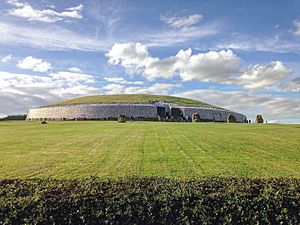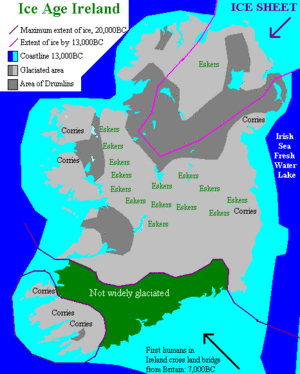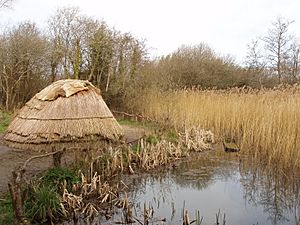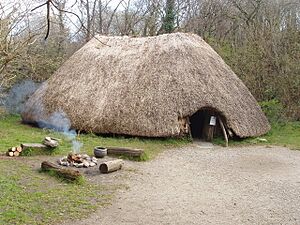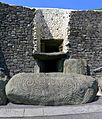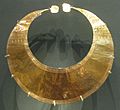Prehistoric Ireland facts for kids
The prehistory of Ireland is like a giant puzzle put together by archaeologists. They study old objects and sites to understand what happened before written records began. This story starts around 10,500 BC, when the first people settled in Ireland. It ends around 400 AD, when Christianity arrived and people started writing things down.
Ireland's prehistory covers several big periods: the Paleolithic (Old Stone Age), Mesolithic (Middle Stone Age), Neolithic (New Stone Age), Bronze Age, and Iron Age. Unlike much of Europe, Ireland wasn't invaded by the Romans. This means its written history began a bit later.
Two periods left behind the most amazing finds. The Neolithic period is famous for its huge stone tombs called megaliths. The Bronze Age is known for beautiful gold jewelry, as Ireland was a major center for gold mining back then.
Ireland has many boglands, which are like natural time capsules. The special conditions in bogs can preserve ancient things incredibly well. This includes bog bodies (ancient human remains), a Mesolithic fish trap made of wicker, and even a delicate Bronze Age textile with horse hair tassels!
Contents
The Old Stone Age (Palaeolithic)
During the last Ice Age, huge sheets of ice, over 3,000 meters thick, covered Ireland. This ice crushed rocks and bones, wiping out almost all signs of early human life. It was a very cold, Arctic-like land, or tundra.
Around 17,500 to 12,000 years ago, the climate got warmer. This allowed hunter-gatherers to move into northern parts of Europe. They followed animals like reindeer.
Britain and Ireland were once connected by a land bridge. But this link disappeared early, around 14,000 BC. This was before many plants and animals could cross into Ireland. That's why Ireland doesn't have snakes today!
The earliest clear sign of humans in Ireland is a bear bone found in a cave in County Clare in 1903. It has cut marks from stone tools. Scientists used radiocarbon dating to find out it's about 12,500 years old. This shows people were in Ireland by 10,500 BC.
After this, the climate got cold again during a period called the Younger Dryas (10,900 BC to 9700 BC). This might have caused people to leave Ireland. When the cold period ended, sea levels kept rising, and the land bridge never returned.
The Middle Stone Age (Mesolithic: 8000–4000 BC)
The last Ice Age ended in Ireland about 10,000 to 12,000 years ago. The first signs of people after the ice melted date to around 8000 BC. These were Mesolithic hunter-gatherers.
They lived all over the country. Important sites include Mount Sandel in County Londonderry and Lough Boora in County Offaly. By the time these first settlers arrived, Ireland was already an island. They came by boat from mainland Europe. Many Mesolithic sites are found along the coast. These early people relied a lot on the sea for food.
Mesolithic hunter-gatherers ate a mix of seafood, birds, wild boar, and hazelnuts. They hunted with spears, arrows, and harpoons. These tools had small stone blades called microliths. They also gathered nuts, fruits, and berries.
They lived in shelters made by stretching animal skins over wooden frames. They cooked their food over outdoor fires. During this time, Ireland's population was probably only a few thousand people.
The New Stone Age (Neolithic: 4000–2500 BC)
Around 4500 BC, a new way of life arrived in Ireland. This "Neolithic package" included farming, new types of houses, and stone monuments. People brought sheep, goats, cattle, and cereals (like wheat and barley) from Europe. The population then grew a lot.
At the Céide Fields in County Mayo, you can see an ancient Neolithic farm system. It's one of the oldest known in the world! Small fields were separated by stone walls. Farmers grew wheat and barley there between 3500 and 3000 BC. Pottery also appeared around the same time as farming.
- Different types of megalithic tombs
-
Creevykeel court cairn, County Sligo.
-
Knowth, a passage tomb located at Brú na Bóinne.
-
Poulnabrone dolmen, a portal tomb located at The Burren.
-
Glantane East wedge tomb.
The most amazing thing about the Neolithic in Ireland was the sudden appearance of huge stone monuments. These are called megalithic tombs. They were important places for religion and ceremonies. Inside many of them, archaeologists have found human remains (often cremated) and grave goods. These goods include pottery, arrowheads, beads, and axes.
There are over 1,200 known megalithic tombs in Ireland. They are mostly divided into four main groups:
- Court cairns – These tombs have an entrance courtyard. They are found mostly in the north of Ireland. They are thought to be the oldest type.
- Passage tombs – These are fewer in number but are the most impressive in size. They are found mainly in the north and east. The biggest ones are in the "cemeteries" of the Boyne, Loughcrew, Carrowkeel, and Carrowmore. The most famous is Newgrange, a World Heritage Site. It was built around 3200 BC. At the winter solstice, the rising sun shines into the tomb's burial chamber. Another Boyne tomb, Knowth, has the world's earliest map of the Moon carved into stone!
- Portal tombs – These are the well-known dolmens. They have three or more upright stones supporting a large flat capstone, like a table. They are found in the southeast and north.
- Wedge tombs – This is the largest group, found mostly in the west and southwest. They are the latest type of megalithic tomb, built towards the end of the Neolithic. They are named for their wedge-shaped burial chambers.
At its peak, Ireland's population was probably over 100,000 people. But around 2500 BC, there seems to have been an economic downturn, and the population dropped for a while.
The Copper and Bronze Ages (2500–500 BC)
New people, known as the Bell Beaker People, brought metalworking to Ireland. They made pottery shaped like an upside-down bell.
The Copper Age began around 2500 BC. This is when people started using copper. The true Bronze Age began around 2000 BC, when copper was mixed with tin to make bronze. Bronze is much stronger than copper.
Bronze was used for weapons and tools. Swords, axes, daggers, and even horn-shaped trumpets have been found. Irish craftspeople were especially good at making these trumpets.
Copper was mined in Ireland, mostly in the southwest. Tin was brought in from Cornwall in Britain. The oldest known copper mine in Ireland was at Ross Island in County Kerry. It was used between 2400 and 1800 BC. Another well-preserved mine is at Mount Gabriel in County Cork. Mines in Cork and Kerry might have produced as much as 370 tonnes of copper during the Bronze Age! This suggests Ireland was a major exporter of copper.
Ireland also had a lot of native gold. The Bronze Age was when Irish craftspeople started working with gold a lot. More Bronze Age gold treasures have been found in Ireland than anywhere else in Europe. Irish gold ornaments have even been found in Germany and Scandinavia.
Early gold items included simple but beautiful gold lunulae (moon-shaped necklaces) and thin gold disks. Later, twisted gold torcs (collars) became popular. Gold earrings, sun disks, bracelets, and special amulets were also made.
Smaller wedge tombs continued to be built during the Bronze Age. People also kept using older megalithic monuments for burials. Towards the end of the Bronze Age, single-grave cists appeared. These were small stone chests buried underground. Many stone circles were also built at this time, especially in Ulster and Munster.
During the Bronze Age, Ireland's climate got worse, and many forests were cut down. The population at the end of the Bronze Age was probably around 100,000 to 200,000. The Bronze Age in Ireland lasted until about 500 BC, which was later than in other parts of Europe and Britain.
The Iron Age (500 BC – AD 400)
Tribes of Ireland according to
Ptolemy's Geographia (written c. 150 AD).
The Irish Iron Age began around 500 BC. It lasted until the Christian era in Ireland, which brought the first written records. This period is often linked to the arrival of the Celts in Ireland. The Celts spoke early forms of the Irish language.
During this time, the Roman Empire ruled neighboring Britain. Roman interest in the area led to some of the earliest written information about Ireland. A geographer named Ptolemy recorded the names of Irish tribes in the 2nd century AD.
The Celtic languages of Britain and Ireland are divided into two groups: Goidelic (like early Irish) and Brittonic (like early Welsh). When written records first appear around the 5th century, Goidelic is found in Ireland.
The late Iron Age saw some big changes in human activity. There was a period from about 100 BC to AD 300 where economic and cultural growth seemed to slow down. Then, in the 3rd and 4th centuries, there was a quick recovery. This recovery might be connected to a "Golden Age" in Roman Britain.
Archaeological finds show trade with Roman Britain, especially in northern Leinster (around modern County Dublin) and along the coast of County Antrim. Burials where bodies were not cremated also became common in Ireland during the 4th and 5th centuries.
Examples of La Tène style (Iron Age Celtic art) from Ireland are rare, but they are very high quality. These include sword scabbards from Ulster and the Petrie Crown. Interestingly, this style seemed to come alive again in Ireland during the early Christian period. It influenced the beautiful art of the Book of Kells.
The Broighter Gold hoard, found in Ulster, is from the 1st century BC. It includes a small model boat, a spectacular gold torc with fancy designs, and other gold jewelry. Some of these items might have been imported from the Roman world.
This period also saw the beginning of some early historical records about Ireland.
Images for kids
-
The Moss-side hoard of Mesolithic Bann flake tools and blades, Ulster Museum.
-
The entrance passage to Newgrange, and the entrance stone
-
The Malone Hoard of 19 luxury polished Antrim porcellanite axe-heads, dated 4,500-2,500 BC, found in Belfast, Ulster Museum.
-
the Gleninsheen Gorget, 800-700 BC, National Museum of Ireland, no. 12 in A History of Ireland in 100 Objects.
-
Twisted Gold Pennanular Ring, Late Bronze Age, Hunt Museum, Limerick.
-
Tribes of Ireland according to Ptolemy's Geographia (written c. 150 AD).
-
Gold model boat from the Broighter Hoard, c. 100 BC.
-
Model reconstruction of the circular building at Navan Fort, c. 100 BC.
-
Clonycavan Man, died 392 –201 BC, NMI
-
End of the Dunaverney flesh-hook
-
Part of the Dowris Hoard
-
Tongue-shaped bronze dagger, Hunt Museum
-
Late Bronze Age bracelet from Castlederg, c. 950-800 BC
-
Late Bronze Age gold "gorget", 800-700 BC, found in County Clare. NMI, Dublin


